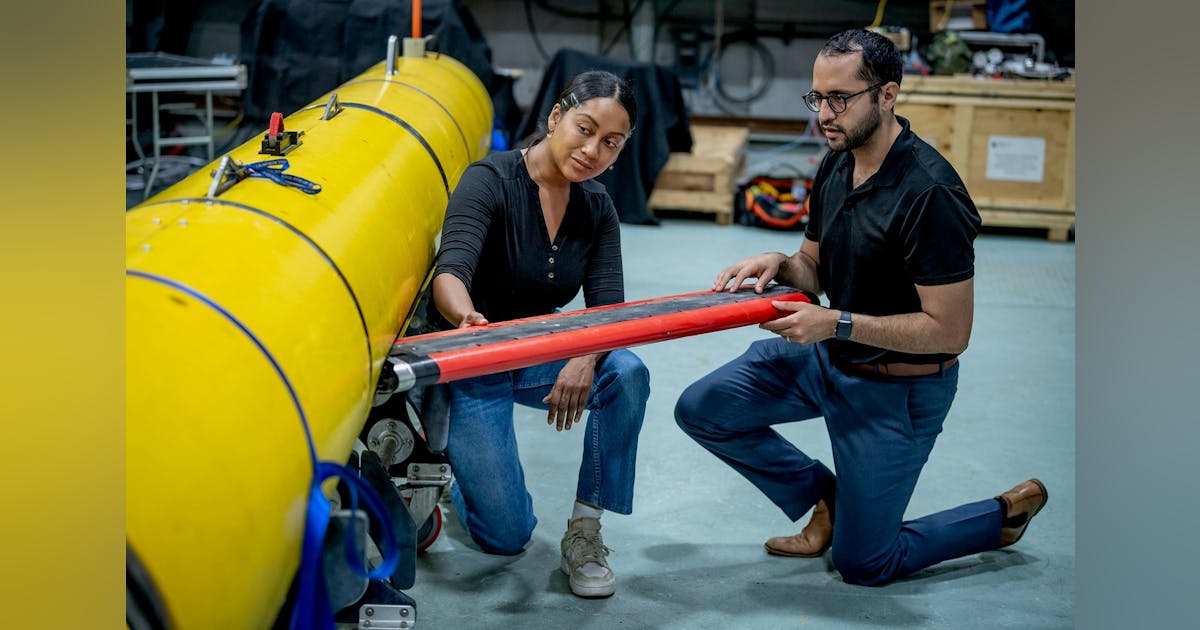Navy Enlists General Dynamics for UUV Enhancements: Pioneering the Future of Undersea Sensing
Progressive advancements in uncrewed underwater vehicles (UUVs), also known as ocean drones, are revolutionizing naval operations, exploration, and defense initiatives. In July 2025, the U.S. Navy’s Naval Research Laboratory (NRL) assigned General Dynamics Mission Systems a $21.5 million venture to upgrade Black Pearl-class UUVs with state-of-the-art sensor and mission payloads. What implications does this hold for UUV technology and the future of maritime exploration? Let’s delve into it.
The Black Pearl: Cutting-Edge Ocean Investigator
The Black Pearl-class UUV remains a linchpin in the Navy’s subaquatic arsenal. Initially crafted by Bluefin Robotics and currently managed by General Dynamics following their acquisition in 2016, this 16.2-foot, 1,650-pound autonomous marine vehicle offers:
- Diving capability reaching 1,300 feet
- More than 24 hours of operation with a single charge
- Speeds reaching 5 nautical miles per hour
Grounded in the proven Bluefin 21 UUV platform, it highlights a modular design, customizable payloads, and extended mission durations—ideal for demanding military and scientific purposes.
Evolving Needs: Why Upgrade?
The demands of naval operations are in constant flux. As new military challenges, research needs, and technologies arise, UUVs must also advance. The Black Pearl fleet supports:
- Research into underwater warfare
- Mine countermeasure (MCM) efforts
- Anti-submarine warfare (ASW)
- Distributed sensing and environmental monitoring
Each mission necessitates new sensors, processing systems, and communication modules. The UUVs need to embrace newly devised payloads from NRL, including advanced sonar, environmental sensors (measuring depth, sound velocity, temperature, and currents), alongside experimental acoustic communication systems. The upgrade necessitates not just software adjustments but also physical redesigns for the seamless incorporation of these sophisticated payloads.
Innovative Marine Technology: What’s New?
The Black Pearl and its Bluefin versions are crafted for maximum adaptability:
- Swappable payload sections for rapid field modifications
- Replaceable battery modules to match mission durations
- Customizable mission configurations for mine hunting, mapping, or data collection on one platform
Emerging payloads and features include:
- Broadband low-frequency sonars to detect mines and submarines
- Environmental data sensors
- Acoustic modem research modules for new underwater communication methods
- Over-the-horizon communication utilizing Iridium SATCOM for real-time surfacing updates
- High-definition cameras and optical sensors for detailed mapping and inspection
- Intelligent navigation systems with a precision drift of ≤ 0.1% of the distance traveled
Equipped with experience in integrating over 100 sensor and payload types within their aquatic vehicle family, General Dynamics and Bluefin Robotics are uniquely positioned to execute the upgrade efficiently and economically, leading to the Navy’s award of a sole-source upgrade contract.
Unmanned Underwater Vehicles: Their Broad Impact
The importance of this upgrade is substantial. Oceans are vast, enigmatic, and frequently hostile. Uncrewed vehicles like the Black Pearl:
- Enhance operator safety: no human risks in perilous settings like minefields
- Facilitate persistent surveillance: extended missions reveal activities unseen by satellites or ships
- Propel research and discovery: gathering essential environmental and oceanographic data supports both defense and science
From search-and-rescue efforts after aerial disasters to undersea cable inspections and submersible treasure hunts, achievable missions render such tasks routine rather than extraordinary.
The Power of Modular Payloads
A significant trend in UUV development is modularity. Bluefin-12 and Bluefin-21 platforms exemplify this:
- Over 4,000 cm³ payload space for swift sensor integration
- Open-architecture compatibility for quick tech swaps
- Automated target recognition and advanced side-scan sonar for precision mapping and mine detection
This flexibility allows a UUV to depart for mine hunting one week and, post a quick payload swap, embark on an environmental survey the next. This adaptability saves time, costs, and expands operational potential for the Navy and research industries.
The Human Element in UUV Operations
Even as these vehicles operate autonomously, it’s the expert teams at General Dynamics Mission Systems and NRL who conceive, integrate, and run them:
- Engineers design hulls, controls, and payload interfaces
- Software developers craft advanced navigation, sensing, and AI code
- Field operators deploy and retrieve the UUVs from research ships or naval vessels
- Research scientists analyze enormous data sets for strategic and scientific insights
The Army’s collaboration with the Navy coupled with General Dynamics’ history of designing from nuclear submarines to specialized UUVs positions them at the forefront of marine technological advancements.
Global Trends: The Undersea Arms Race
The upgrades to the Black Pearl occur amid a global trend toward modernizing and automating underwater fleets. Competitors like Northrop Grumman and Boeing are advancing flexible, modular unmanned systems. As the competition heats up, swift sensor and communication suite integration becomes a critical advantage.
Pro Insights: Maximizing UUV Potential
- Embrace flexibility: Select UUV platforms with a modular, open-architecture design for mission resilience.
- Focus on data: UUV value lies in the quality and accessibility of their payload-generated data.
- Support essentials: Reliable engineering, maintenance, and operator training are as vital as hardware specifications.
- Collaborate closely: Collaborations between military, industrial, and scientific professionals yield superior results.
Field Success: A Black Pearl Case Study
NRL maintains tradition in field-modifying UUVs during research expeditions. In one instance, a Black Pearl was outfitted with broadband sonar and environmental sensors for detecting man-made objects and mapping intricate seabed habitats in a direct 24-hour mission. The mission preparation time was significantly reduced by 60% compared to previous ‘hard-wired’ vehicles, showcasing a real-world force enhancement.
Looking Ahead: The Future of Underwater Autonomy
What’s on the horizon for uncrewed underwater vehicles?
- Artificial intelligence: More intelligent vehicles with the ability to classify targets, dodge obstacles, and enhance routes autonomously.
- Enhanced communications: Hybrid acoustic-satellite systems to streamline data transmission during missions.
- Extended endurance: Cutting-edge batteries and energy harvesting capabilities for protracted underwater durations.
- Environmental contributions: Utilizing UUVs beyond military advantage for marine science, reef restoration, and climate observation.
The Passionate Teams Behind UUV Innovation
Every successful UUV endeavor is driven by passionate innovators—engineers who are adept at tackling complex challenges, exploration enthusiasts fascinated by the depths, and naval professionals entrusting robotics to safeguard sailors. The General Dynamics team embodies this ethos by blending military precision, academic curiosity, and a startup-style rapid prototyping approach.
Making the Right UUV Choice
Considering your own unmanned underwater project? Consider these expert points:
- Identify mission objectives: Is it for surveying, inspection, search, or warfare purposes?
- Define payload needs: Preferred sensor types, data requirements, and mission longevity.
- Evaluate upgrade potential: Is your UUV compatible with future tech integrations?
- Select skilled partners: Collaborate with experienced integrators to avert unpredictable challenges.
Remember: in ocean robotics, an ideal platform adapts to your needs, not the reverse.
Conclusion
The Navy’s partnership with General Dynamics underscores how modular, upgradeable underwater vehicles are revolutionizing both military and civilian ocean ventures. Platforms like the Black Pearl, supported by specialized teams and cutting-edge payloads, assure a future for undersea research and defense that is smarter, safer, and more adaptable. For those aiming to navigate the domain of uncrewed underwater technology—whether for security, science, or industry—seek out partners and platforms that emphasize innovation, flexibility, and vast expertise. The ocean’s vast and the possibilities boundless.













